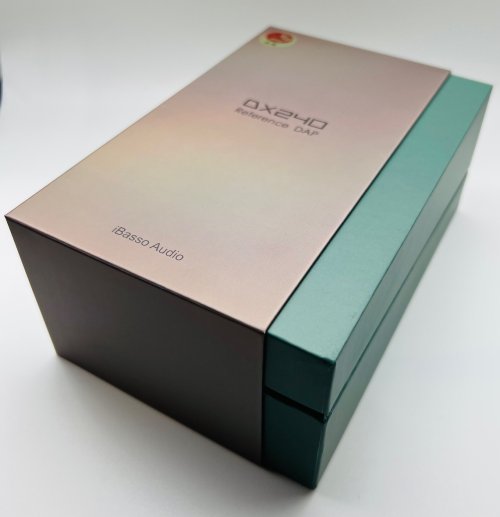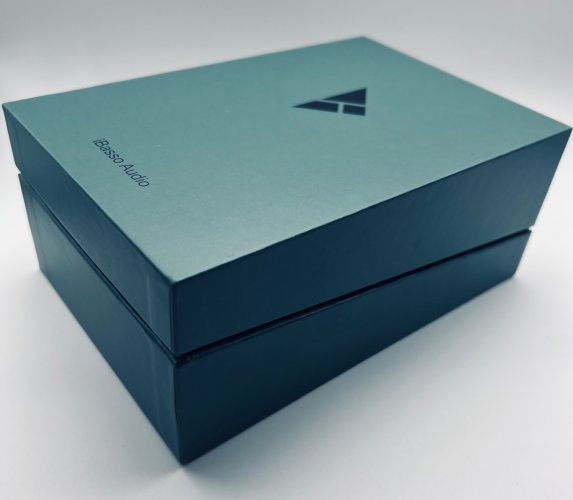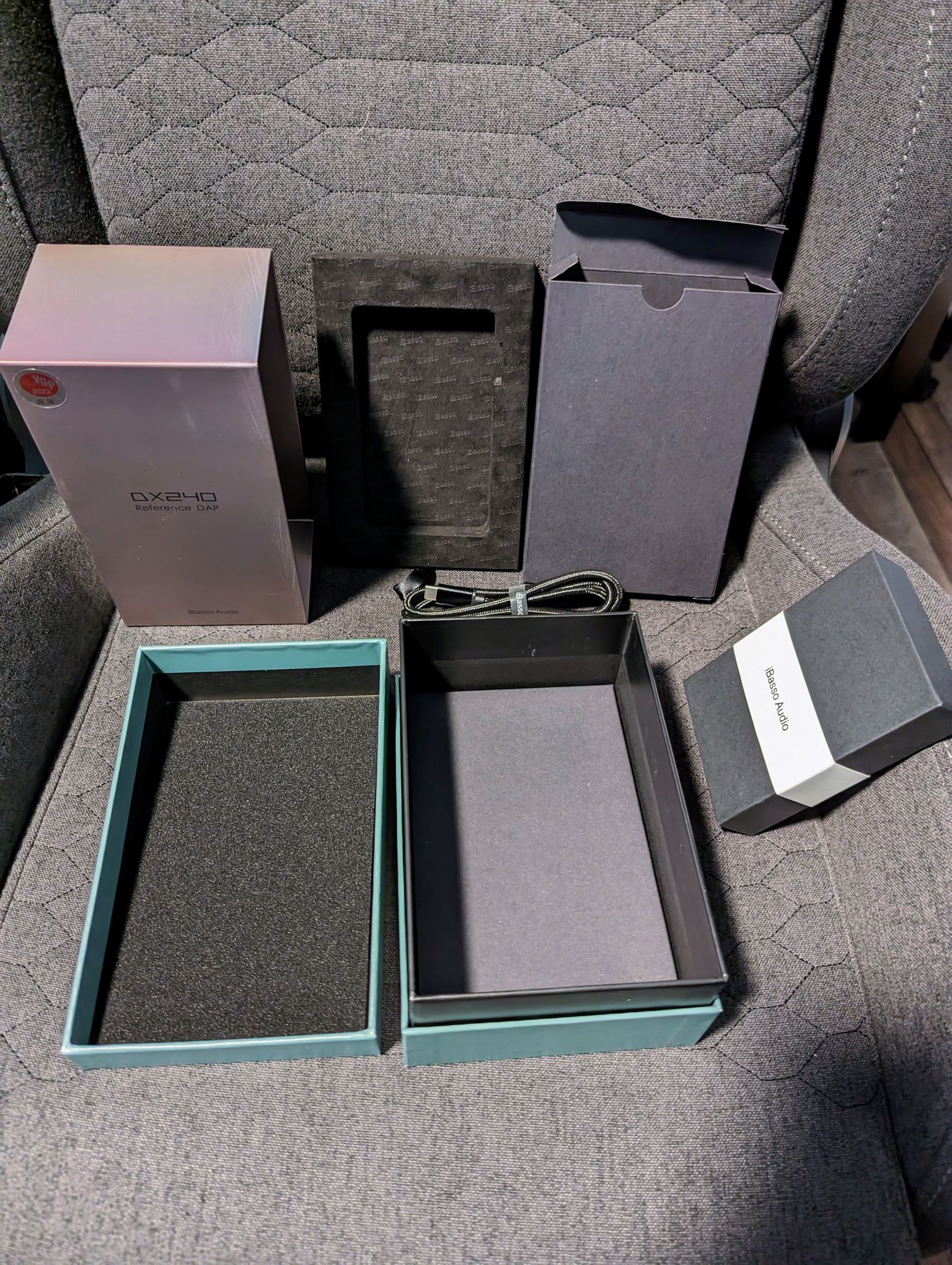Good day to you, my fellow audio addicts

Layman1 being a conscientious kind of chap, I hesitate to further feed your collective habit, but this new product is surely too good not to share, right?

China’s iBasso have by now thoroughly established themselves as a well-known and respected manufacturer of DAP’s (not to mention IEMs, cables etc. Which I just mentioned)
Today, I shall be reviewing their latest model; the DX240, along with their newly-offered AMP8 Mk II.
The details of the DX240 can be found on iBasso’s website here:
https://ibasso.com/product/dx240/
A great deal more information, Q&A, reviews and impressions may all be found on the product thread here on Head-Fi:
https://www.head-fi.org/threads/dx2...the-free-amp3mod-on-our-facebook-page.959528/
The RRP at time of writing was approximately $949 (price may vary from one dealer or region to another). When I checked on the website today, it is available only in black (which is the colour I chose anyway), but I have seen dark blue and dark green versions too, so best to check with your local dealer if not ordering online.
My sincere thanks to Paul and the team at iBasso, for providing me with a review unit in exchange for an honest review.
Well, all necessary preliminaries and polite introductions having been taken care of, why don’t we see what the DX240 actually looks like? Of course, those familiar with my style of writing (and who, to my astonishment, still continue to read my ramblings) will know that this most straightforward of tasks may be accomplished by proceeding forthwith to the upcoming section, that, with commendable abstemiousness in these straitened times, is simply titled ‘Photos’
 Photos
Photos:







 Unboxing, packaging and accessories
Unboxing, packaging and accessories:
I feel the packaging and accessories are classily designed and a credit for a product at this price point.
Again iBasso have slightly changed the design of the box with the DX240, losing the clamshell opening featured with the DX300, for a more conventional one that separates smoothly into two halves, with a stylish angular cut into the sides of the box.
There’s a nice and array of accessories, including a burn-in cable, premium-looking charging cable and an adaptor which will serve you well if you wish to use the DX240 as part of an audio chain perhaps involving an external amp.
The DX300 comes with a TPU case, which fits well and doesn’t impede usability.
Ergonomics & UI:
I tend, especially with DAP reviews to leave aside the lengthy tracts talking about the hardware and software specifications in all their excruciating minutiae. I’m working on the principle that basically, anyone who is interested in the fine details of such things will have doubtless have already followed the product thread or discussions here on Head-Fi already and found out whether or not the product meets their hopes and expectations. And of course, the link I posted to the product page on iBasso’s website will contain extensive information on such things too.
I’ve found that with DAP’s, many people seem to make up their mind regarding their initial interest to a large extent based on the price, product specifications, design and perhaps its position within the manufacturer’s existing line-up, only later delving into impressions and reviews concerning the fine details of the sound and performance. So, I will be choosing to focus mostly on the latter here.
They say to write about what you know, and since Layman1 is an unrepentant Luddite, I shall avoid provoking mirth or derision by talking ignorantly about streaming, wireless and installation of apps and so forth.
I put music on a micro-SD card and install it. I plug in some
wired IEMs, thank you very much, and I go straight to Mango mode and press play, assuming I have not forgotten to first power on the DAP in the process

So, I am happy to report that I find the DX240 to be extremely fast in use. I personally find scrolling a great deal smoother and more intuitive than I did on the DX300, although I should add in fairness that I think I only updated the firmware on that device once; I refer you again to my previous statement about being an unrepentant Luddite

Switching between sub menus, scrolling through playlists, displaying of album art, everything is smooth and effortless.
Also, I much prefer the size of the DX240, not to mention its weight (which I just mentioned). It’s vastly more portable and ergonomic to use, and – for my tastes at least – a more aesthetically pleasing design. I also love the matte black finish of this DAP. The way that colour is offset by the stylish gold volume wheel and sockets… I literally had to stop myself from drooling all over it when I opened the box (fear not, I’m seeking help for this issue)

The screen too is a delight; bright, vivid and for my preferences, a pretty ideal size.
If all of this has piqued your interest, read on to find out the DX240 sounds; in the section of the review named – appropriately enough – “The Sound”
The Sound:
To test this DAP, I listened predominantly with the Unique Melody MEST, as I’d say it’s probably the best IEM I have in terms of combing technical performance and low-end depth and impact.
Added to that, of the IEMs I have with similar sound qualities, I’d say it’s the one with whose signature I am most familiar, hence it’s an ideal choice for critical listening with a new DAP.
Test tracks were picked from a varied group of genres, and were predominantly lossless FLAC or WAV files, with many of those in 24 bit hi-res format.
I’ve been doing most of my listening recently using my two Sony DAPs (WM1Z and modded ZX300).
The main reason is because these DAPs (using modded FW) have an AI-based remastering/upscaling function, which upscale mp3 and 16-bit FLAC files to sound like hi-res (24-bit) FLAC files. Whilst almost all of my music is in FLAC, and probably at least a third of that is in hi-res FLAC, I do have certain songs that I regularly listen to which I have only been able to find in mp3 form (Chinese pop songs mainly), and some of them are even low quality mp3 (128kbps or so).
Listening with the Sony AI function makes a noticeable difference (and even improves all my 16-bit FLAC files), and hence is why I tend to listen mainly to those DAPs.
With this in mind, read on for how the DX240 sounds!
Sound signature:
I mention all this about the Sony DAPs because listening again to an iBasso DAP has a lovely warm ‘coming home’ type of feeling. There’s just a classic kind of ‘house sound’ that iBasso have perfected over their many DAPs; each one with its own tweaks and variations on that sound, but still with the family DNA showing through.
So after listening to a lot of different music from various genres, and with a few different IEMs, the key traits that are coming through here would be a quite neutral and balanced sound, with very good technical performance. This combination does not, however, result in an analytical or clinical sound signature. As usual, iBasso have perfected the art of allowing a degree of musicality to come through, achieved to my ears with an extended and solid sub-bass, with a very slight lift in the mid-bass and a tinge of warmth in the lower mids. All this is very subtly done though, hence why you will commonly hear talk of the neutrality and balanced nature of the DAP. It has a spacious soundstage, well-executed separation and imaging and excels in detail retrieval, but pairs this with an energetic and dynamic sound, further increasing engagement with the music.
I found the DX240 able to drive all of my main IEMs, with minimal to zero hiss (CA Solaris 2020 and Dorado 2020 owners, take note!). I’d also not that I didn’t find a single IEM pairing that I had any negative impressions about. The DX240’s sound signature lends itself well to pairing with pretty much anything you could throw at it due to its comparatively transparent nature, whilst giving a little boost in the sub-bass with that little bit of ‘enjoyment factor’ sprinkled over the top for good measure.
AMP 1 Mk III (stock) vs AMP 8 Mk II:
I have added this in, as I also got the AMP 8 Mk II and thought it would be a comparison people would be interested in!
Well, I’ve already described the sound of the stock AMP 1 Mk III, so how does the AMP 8 Mk II compare?
Well, the difference is not huge; they both share elements of that same audio DNA to which I alluded previously. However, I hear the AMP 8 Mk II as taking that ‘tinge of musicality’ a step further; more mid-bass and a bit more impact and rumble overall, plus that warmth extends into the mids, again increasing the warmth slightly over that of the stock AMP unit, and making it slightly darker-toned in comparison to the stock AMP unit. Aside from this, most other factors seem fairly equal to me, particularly in terms of technical performance.
Overall, whilst I don’t feel there’s a huge difference, I do feel there is a difference and since it relates mainly to tonality, I’d suggest that the stock AMP might pair better with warmer IEMs, whereas the AMP 8 Mk II would possibly be a better match for comparatively more neutral IEMs.
This sweeping generalisation of course assumes that you are looking for a certain kind of match up; however the flip side of this is that you could make a dark, warm, rich and bassy set of IEMs (e.g. CA Solaris 2020, EE Phantom) even more dark, warm, rich and bassy by pairing them with the AMP 8 Mk II, and similarly for more neutrally-tuned IEMs with the AMP 1 Mk III
 Conclusion
Conclusion:
So, whilst this is not a new flagship (and indeed occupies a somewhat unusual position in the ever-expanding iBasso line up), it is in my opinion nevertheless an outstanding new product. It offers excellent sound quality and technical performance, allied to a snappy and smooth UI, all in an eminently portable package.
It’s gorgeous to look at, feels solid and well-built and with the modular AMP system, will continue to offer options to experiment with different sound signatures long after this review is gathering dust in the Head-Fi archives.
And as usual with iBasso, all of this has been achieved at a price point that is highly competitive with other similar offerings in the marketplace.
It’s been a pleasure to listen to and I hope you’ve enjoyed reading about it



























